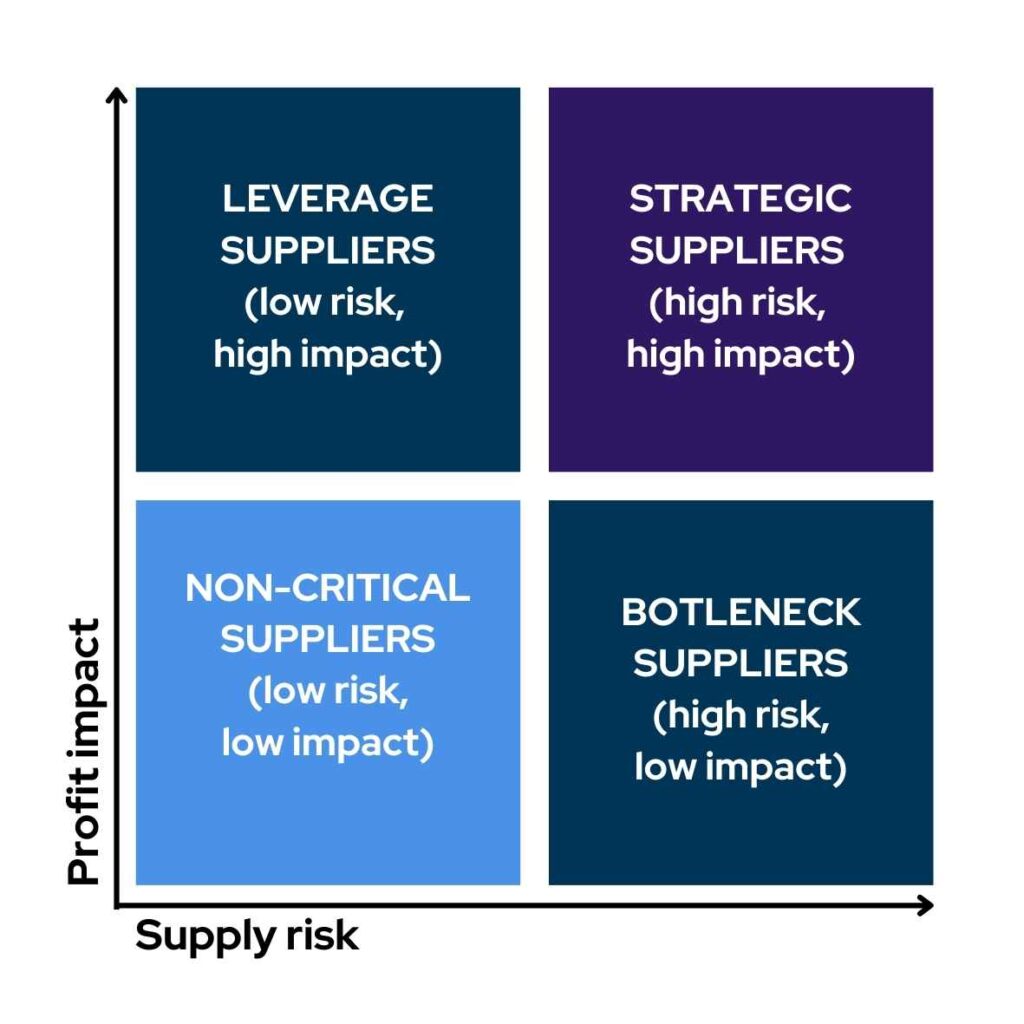A Guide to Supplier Management for Small Manufacturers
Effective supplier management can mean the difference between thriving and merely surviving in today’s competitive market. Yet many struggle with this crucial aspect of operations, often relying on outdated spreadsheets or, worse, to track their supplier relationships.

What is supplier management?
Supplier management is a systematic process for collecting, organizing, and maintaining information about the companies that provide your raw materials, services, and components.
But it’s more than just keeping a folder of contact information on your desk. Modern supplier management is a strategic function. It includes everything from initial supplier selection and generating supplier lists to performance monitoring, risk management, and relationship building.
Think of it as the central nervous system of your business’s procurement management. Just like your nervous system coordinates all body functions, your supplier management system synchronizes all supplier-related activities, maintaining smooth operations across your manufacturing process.
Managing suppliers: then vs. now
Traditional supplier management often focused solely on getting the lowest price from suppliers. Today’s approach is far more sophisticated, recognizing that true value comes from building strategic partnerships with key suppliers.
This shift is particularly relevant for small manufacturers, who benefit more from reliable, quality-focused supplier relationships than purely price-driven transactions.
Modern supplier management leverages technology to automate routine tasks, track performance metrics, and provide real-time insights into supplier relationships. This is vital for small manufacturers who need to maximize efficiency with limited resources.
The importance of effective supplier management
Effective supplier management directly affects your profitability in quite a few ways:
- Reduced procurement costs through better negotiation and consolidated purchasing.
- Lower inventory carrying costs through improved supply chain coordination.
- Decreased risk of production delays and quality issues.
- Enhanced ability to respond to market opportunities and challenges.
- Improved cash flow through better payment term management.
Small manufacturers face unique supply management challenges. Unlike larger corporations, you’re likely working with limited resources while trying to maintain quality, manage costs, and ensure reliable supply chains. This makes effective supplier management not just important but essential.
Manual supplier management processes, in particular, consume valuable time that could be better spent on strategic activities. Without an effective supplier management system, a single supplier quality issue can halt your entire production line. Poorly managed supplier relationships can also lead to higher costs and missed opportunities for bulk discounts. Moreover, you might be missing early warning signs of potential supply chain disruptions.
Comprehensive manufacturing software can make supplier management far easier to implement, leading to more productivity for your business, as we will see.
Supplier management core components
Successful supplier management rests on five fundamental pillars that work together to create a strong procurement strategy. Let’s examine each component and its role in your manufacturing operation.
1. Supplier identification and selection
The foundation of effective supplier management begins with choosing the right suppliers. This process involves:
- Establishing clear selection criteria based on your specific needs.
- Conducting thorough research into potential suppliers’ capabilities.
- Evaluating financial stability and business longevity.
- Checking references and past performance.
- Assessing technical capabilities and quality standards.
Remember, the goal isn’t simply to find the lowest price but to identify suppliers who can consistently meet your quality standards, delivery requirements, and volume needs.
2. Contract negotiation and management
Once you’ve identified potential suppliers, establishing clear agreements becomes crucial. Effective contract management includes:
- Clearly defined service level agreements (SLAs)
- Specific quality standards and acceptance criteria
- Delivery schedules and lead times
- Pricing structures and payment terms
- Dispute resolution procedures
- Performance review schedules
3. Performance monitoring
Regular monitoring helps ensure suppliers meet your expectations and identifies potential issues before they become problems. Key areas to monitor include:
- Quality metrics and defect rates
- On-time delivery performance
- Response time to issues
- Cost competitiveness
4. Risk management
Protecting your supply chain from disruption is crucial. Design and employment strategies for:
- Supply chain diversity
- Quality control processes
- Financial stability monitoring
- Geographic risk assessment
- Contingency planning
5. Relationship building
Strong supplier relationship management can give your manufacturing operation a competitive edge. Focus on:
- Regular communication
- Collaborative problem-solving
- Shared goals and objectives
- Long-term partnership development
- Fair and timely payment practices
Understanding supplier management lists
Different types of supplier management lists help you manage supplier relationships more effectively.
Approved vs. preferred supplier lists
- Approved Supplier Lists (ASL): These are suppliers that have met your minimum requirements for quality and compliance. They are authorized for use.
- Preferred Supplier Lists (PSL): These suppliers are actually a subset of the ASL. They’ve typically demonstrated superior performance or offer special advantages. Simply put, these vendors are the top choice, used whenever possible.
Strategic vs. tactical suppliers
- Strategic suppliers: Provide critical components or services that directly impact your product quality or ability to meet customer demands. These relationships require the most attention and resource investment.
- Tactical suppliers: Provide necessary but more easily replaceable products or services. While important, these relationships typically require less intensive management.
Supplier tiers
Along with supplier designations, most manufacturing operations benefit from organizing suppliers into tiers, denoting the level of importance to operations:
- Tier 1: Critical partners who provide essential materials or components.
- Tier 2: Important suppliers who provide necessary but less critical items.
- Tier 3: Suppliers of commodity items or easily replaceable services.
Supplier segmentation strategies
For small manufacturers, strategic supplier segmentation is crucial, using the supplier types listed above. It helps you focus your time and effort where they’ll have the most impact. Here are two of the most common strategies used.
The Kraljic matrix
The Kraljic Matrix organizes suppliers based on two key factors: supply risk and profit impact. This creates four distinct categories:
- Strategic suppliers (High Risk, High Impact)
- Critical to your operations.
- Limited alternative sources.
- Require close partnership and regular engagement.
- Example: Custom component manufacturers for your core products.
- Leverage suppliers (Low Risk, High Impact)
- Significant spending volume.
- Multiple alternative sources are available.
- Focus on negotiating the best terms.
- Example: Standard raw material providers.
- Bottleneck suppliers (High Risk, Low Impact)
- Specialized products with few alternatives.
- Lower overall spending.
- Focus on securing supply and finding alternatives.
- Example: Specialized tool or equipment providers.
- Non-critical suppliers (Low Risk, Low Impact)
- Routine, easily replaceable items.
- Multiple sources are available.
- Focus on efficiency and automation.
- Example: Office supplies or standard maintenance items.

The Pyramid approach
The Pyramid approach offers a simpler alternative that is exceptionally suitable for smaller manufacturers. It organizes suppliers into the three supplier tiers mentioned above:
Tier 1: Strategic partners
- Top 15-20% of suppliers.
- Critical to your operation.
- Require regular engagement and relationship building.
Tier 2: Preferred suppliers
- Middle 30-40% of suppliers.
- Important but not critical.
- Regular performance monitoring.
Tier 3: Basic suppliers
- Remaining suppliers.
- Transactional relationships.
- Focus on efficiency and cost.
Implementing your segmentation strategy
- Start with a supplier audit.
- Assess each supplier’s importance to your operation.
- Consider both current and future needs.
- Document your categorization decisions.
- Decide on a segmentation approach.
- Review and adjust categories and approaches annually.
Remember, effective segmentation isn’t about creating rigid categories. It’s about developing a workable framework that helps you manage your supplier relationships more effectively. It will evolve as your business needs change and your supplier relationships develop.
Risk management in supplier relationships
Managing supplier risk isn’t just about avoiding problems—it’s about ensuring business continuity and maintaining competitive advantage. A single supplier issue can have massive effects on operations, making risk management crucial.
Supply chain disruptions can emerge from numerous sources, and small manufacturers need to be particularly vigilant about identifying potential threats. The most common risks stem from supplier financial instability, quality control issues, delivery reliability, and, some instances, geographic concentration.
Natural disasters, political unrest, and economic fluctuations can also significantly impact your supply chain, especially when dealing with international suppliers.
Single-source dependency represents one of the most significant risks for small manufacturers in any scenario. While working with a single supplier might seem efficient and cost-effective in the short term, it can leave your operation vulnerable to devastating disruptions, even shuttering your business.
Building a healthy risk management strategy
Effective risk management starts with thorough supplier assessment. This means looking beyond immediate pricing and quality metrics to evaluate a supplier’s financial health, operational stability, and long-term viability. Modern ERP (enterprise resource planning) systems can help automate much of this monitoring process.
Multi-sourcing remains a keystone of risk mitigation. This doesn’t necessarily mean maintaining active relationships with multiple suppliers for every component. Instead, develop a network of qualified backup suppliers who can step in during emergencies. For critical components, consider maintaining relationships with at least two active suppliers.
Regular supplier performance monitoring plays a crucial role in risk management. By tracking key metrics like delivery reliability, quality consistency, and response times to issues, you can often identify potential problems before they escalate into crises. This allows you to address concerns early and work with suppliers to implement corrective actions.
Supply chain and inventory tracking can greatly increase inventory visibility. They provide insight into lead times and can help detect stoppages or other supply issues early on. Modern manufacturing ERP systems can help automate much of this monitoring process.
Geographic risk considerations
The geographic concentration of suppliers represents another significant risk factor. While local suppliers might offer advantages in terms of communication and delivery times, relying too heavily on suppliers from a single region can expose your operation to regional disruptions.
Consider diversifying your supplier base across different geographic areas when practical.
Financial risk management
Financial risk management extends beyond monitoring supplier stability. It includes managing your own exposure through careful contract terms, payment scheduling, and inventory management. Negotiate payment terms that protect your cash flow while maintaining strong supplier relationships.
Consider employing early warning systems that flag unusual patterns in supplier behavior, such as delayed deliveries or quality issues, which might indicate underlying financial problems.
Building resilience through communication
Finally, open communication channels with suppliers are essential to supply risk management. Regular dialogue helps identify potential issues early and facilitates collaborative problem-solving. Establish clear protocols for escalating concerns and maintaining transparency about expectations and capabilities on both sides.
Performance management basics and metrics
Performance management is another backbone of successful supplier relationships. It provides the data-driven insights needed to make informed decisions about your supply chain. For small manufacturers, the key lies in measuring what matters without getting lost in a sea of metrics.
Establishing meaningful KPIs
Effective supplier performance management starts with selecting the right key performance indicators (KPIs). While large manufacturers might track dozens of metrics, small manufacturers should focus on metrics that directly impact their operations and bottom line.
The most critical metrics typically fall into four categories:
- Quality Metrics
- Track defect rates
- Monitor consistency of product specifications
- Measure overall reliability
- Delivery Performance
- On-time delivery rates
- Accuracy of deliveries
- Flexibility in meeting changing demands
- Adherence to packaging and documentation requirements
- Cost Performance
- Total cost of ownership
- Price stability
- Payment terms
- Minimum order quantities
- Additional charges or fees
- Responsiveness
- Communication effectiveness
- Problem resolution time
- Flexibility in addressing changes
- Technical support quality
Continue reading about supply chain KPIs.
Implementing performance reviews
Regular performance reviews provide the structure needed to maintain and improve supplier relationships. Rather than conducting reviews only when problems arise, establish a consistent review schedule based on supplier segmentation. Strategic suppliers might warrant quarterly reviews, while annual reviews might suffice for non-critical suppliers.
During these reviews, focus on trends rather than isolated incidents. Look for patterns that might indicate emerging issues or opportunities for improvement. Share these insights with your suppliers and work collaboratively to develop improvement plans when needed.
Technology solutions for supplier management
Attempting to manage suppliers without proper technology is like trying to pilot a plane without instruments. It can be done, but it increases the risk of failure. Modern manufacturing ERP software offers powerful tools for managing suppliers and mitigating supply chain risk. These systems can automate monitoring processes, provide early warning indicators, and help maintain clear communication channels with suppliers.
For small manufacturers, investing in such technology might seem costly, but the potential savings in prevented disruptions and improved efficiency often justify the investment. So, while you might be tempted to stick with familiar spreadsheets and manual processes, the complexity of modern supply chains demands more sophisticated technology solutions.
Fortunately, the cost-effectiveness and ease of implementation of modern cloud-based solutions make manufacturing ERP software a viable solution for even the smallest manufacturing or distribution operations.
When evaluating manufacturing software, focus on systems that provide these critical capabilities:
- Automated purchase order generation and tracking.
- Supplier performance monitoring.
- Supplier list management and document management.
- Automated payment processing and reporting tools.
Excellence in supplier management isn’t achieved overnight. It requires commitment, consistent effort, and the right tools. However, for small manufacturers willing to make the investment, the rewards of integrated manufacturing software are substantial.
Key takeaways
- Supplier management is a strategic process concerned with optimizing supplier segments and relationships, ensuring quality, and mitigating supplier risks.
- Modern supplier management leverages technology to automate tasks, monitor performance, and enhance efficiency, which is especially crucial for small manufacturers with limited resources.
- Effective supplier segmentation techniques like the Kraljic Matrix or Pyramid approach help businesses prioritize supplier relationships and allocate management efforts wisely.
- Supplier risk management strategies like multi-sourcing, financial monitoring, and geographic diversification protect against disruptions and ensure supply chain resilience.
- Key performance indicators (KPIs) such as quality, delivery reliability, cost stability, and responsiveness are essential for tracking and improving supplier performance.
- Manufacturing ERP systems streamline supplier management by automating procurement, monitoring risks, and improving efficiency, making them a valuable investment for SMEs.
Frequently asked questions (FAQ)
Key performance indicators for supplier management focus on quality, delivery, cost, and responsiveness. Common KPIs include defect rates, on-time delivery percentage, price stability, and supplier communication effectiveness. Tracking these metrics helps businesses assess supplier reliability and make more informed decisions about their supply chain.
A supplier management framework is a structured approach to selecting, monitoring, and optimizing supplier relationships. It typically includes key components such as supplier segmentation, contract management, performance evaluation, risk management, and relationship-building. Using a framework ensures a systematic, data-driven process that aligns supplier performance with business goals.
Managing supplier performance involves setting clear expectations, tracking key metrics, and maintaining regular communication. Implement a performance review process based on KPIs like quality, delivery reliability, and cost-effectiveness. Use technology, such as ERP systems, to automate monitoring and reporting and collaborate with suppliers to resolve issues and drive continuous improvement.
You might also like: ERP vs MRP – Picking the Right Manufacturing Software for SMEs




